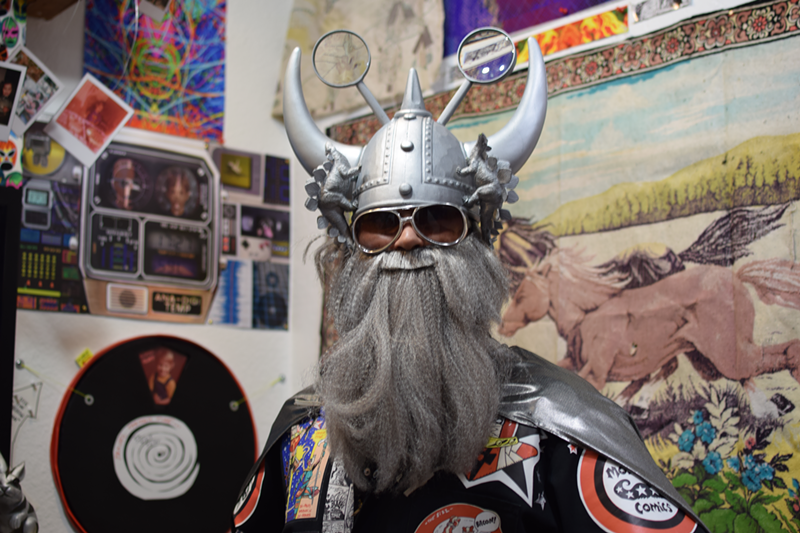There are many fits of laughter when speaking with the founders of Pique, an experimental art gallery in Covington, but the most rapturous — and most telling — happens when they refer to a CityBeat article published about their space in 2016, taped to the side of their refrigerator.
Founder Lindsey Whittle, her multi-colored hair adorned in a headpiece made of lens-less eyeglasses, reads the article’s concluding lines: “Pique seems poised to make even a short-term difference in the local arts scene. Experiments can fail, of course. But that’s also how you learn.”
She and co-founder Annie Brown seem positively tickled by how their experiment has panned out. On Sept. 5, Pique not only celebrated its fourth birthday (complete with cake, pizza rolls and a group hypnosis session) but also marked the culmination of an ongoing event known as The Clubhouse. If you didn’t make it to the event, the clubhouses will remain on view for the next few weeks.
For this show, Whittle, Brown, Whittle’s husband Clint Basinger (who, during our interview, was referred to as “Future-Clint” and was clad in an outfit straight out of a pulpy comic book, with a long gray beard and matching Viking helmet), artist Noel Maghathe and an assortment of other local artists made clubhouses as a sort of installation art. Most of the works were constructed inside the gallery over several weeks, allowing visitors to witness the progress.
The whimsical connotations of clubhouses are heavily noted, with many hearkening back to their childhood for inspiration. However, speaking with the artists about the concepts explored in their respective spaces reveals a depth that adds further pathos to their work.
Basinger, whose clubhouse is part of Pique’s “middle gallery,” had the initial idea for the showcase. Decorated with sheets featuring pop culture icons like the Justice League and The Simpsons, a video of Basinger recounting childhood stories as Future-Clint is also included.
“I just think my childhood is a huge part of who I am and it’s been interesting to see these artists delving back into their childhood and sort of re-examining where they came from and who they are, and who they’re becoming from that,” Basinger says.
Though Brown didn’t have a childhood clubhouse, she did spend much of her childhood outdoors. She says the intention with her clubhouse, which she worked on off-site, is to make the audience feel as if they are outside.
Whittle’s clubhouse is in the bedroom area, where Pique typically hosts Airbnb guests. Abstract shapes are suspended from the ceiling around the bed and act as a replica of “bed sheet spaces” made by children.
“When I think about clubhouses, it’s sort of like a space you’re creating that’s safe and it’s for everybody,” Whittle says.
Made with their partner, Griffin Ritze, Maghathe’s clubhouse design is particularly high-concept. Taking inspiration from their Palestinian heritage, viewers are presented with a clear acrylic box that contains dirt and stones. With those materials, they’re asked to rebuild something that’s “basically unrebuildable.”
“Ours is probably the farthest apart from what a traditional clubhouse would look like,” Maghathe says.
That’s fitting, as Pique isn’t interested in adhering to concepts like “tradition” or even “genre.”
Whittle makes a point of her and Brown being “anti-curators” — not giving any stipulations to the artists for how exactly they should express themselves.
“We curate in the sense that we pick the people we think will do something interesting,” Whittle says, “but we really let them explore the ideas they need to explore in this space.”
There are some arguably “less traditional” traditions that Pique keeps up. One is event start times, which are always at 7:13 p.m., or, to accommodate certain artists, at 13 minutes past another hour. This started after someone in the original planning committee insisted on starting a meeting 13 minutes past the hour, only to not show up.
Another tradition is marathon shows. This past April, Pique hosted “Perform-a-thon,” a 24-hour experience with 35 artists, as part of the Contemporary Arts Center’s performing arts festival This Time Tomorrow. The gallery has plans to repeat the event next April as “Perform-a-Rama,” which will also be live-streamed on YouTube.
Although Pique might not have the biggest team in terms of quantity, Whittle finds that there is strength in numbers when it comes to quality.
”If you have a small amount of people, but they’re amazing people, you can do a lot,” Whittle says.
The Clubhouse is currently on display at Pique Gallery (210 W. Pike St, Covington), though the closing date is TBA. More info: facebook.com/piquesocialmedia.


